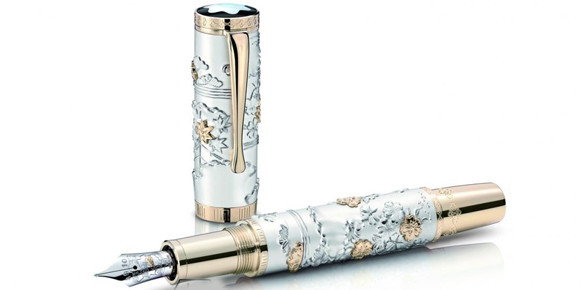
Montblanc have a time-honoured history of creating eye-catching pens that hark back to a distant era and their latest creation features all the hallmarks of the German luxury goods maker.
Strictly limited to just 55 pieces, the Montblanc Homage to Kyoto Artistry pays homage to the fine Japanese artistry of Chiso and features a specially-created Kimono pattern in honour of the centuries-old tradition.
The limited number of 55 pieces is a reference to the genesis of the Chiso tradition in 1555.
For the uninitiated, the artistry of Chiso allows its designers to tell elaborate stories on silk. Two scenes from the fabled Tale of Genji decorate the pens, with the cap featuring the palace and bird from the famous Wakamurasaki scene in the fifth chapter, while the barrel depicts Imperial carts or Gosho Guruma that accompany Genji through the various stations of his life.
Montblanc artisans used a new surface technique to apply the intricate designs to the 925 Sterling Silver cap and barrel that are firstly finely engraved, then refined with a very unique sandblasting process.
A final polish embellishes the silver with partly matt and partly shiny surfaces accentuated with solid gold inlays of spring cherry blossoms and autumn leaves. The champagne gold cone is delicately engraved with a traditional Hanabishi pattern, and the cap ring that separates the upper from the lower part of the writing instrument is decorated with Genji-ko, a line pattern derived from Kodo.
The nib design is inspired by the traditional Kosode, a basic Japanese robe for both men and women worn during the Japanese Edo Period between the 17th and 19th centuries.
The writing instrument comes in a box with a silk inlay, hand-painted by Chiso artisans using the Kyo-Yuzen technique of painting and dyeing silk along with elaborate artwork.
Montblanc was founded by Claus-Johannes Voss, Alfred Nehemias and August Eberstein in Germany in 1908.
Support Vessel 6711 and the Age of Adventure
Yalıkavak Marina: The Land of the Eternal Blue
Industry Brands Drop Anchor in Porto Montenegro
Hainan to build national sports tourism pilot zone
€600,000 price drop on Mondomarine motor yacht My Way
MYS Fleet in Focus: The Timeless Nature of Aquarius
72m Lürssen superyacht Coral Ocean for sale
Riva Opera motor yacht Sula sold
Regent Shanghai Pudong announced for this May
Motorsailer Yacht Le Pietre now for Sale with Engel & Volkers.